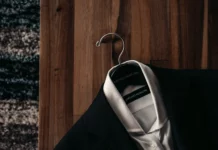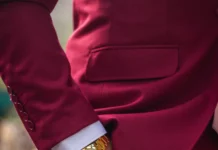 The quest for a flawlessly fitted suit can be tough, but with our guidance, you’ll conquer the challenge with ease.
The quest for a flawlessly fitted suit can be tough, but with our guidance, you’ll conquer the challenge with ease.
If you’ve ever asked yourself “how should suit pants fit?” or “what is a modern fit suit?” then you’re not alone. Finding a well fitted suit can be overwhelming, and difficult. Everything from individual body type, to personal preference, all play a factor. Thankfully with some good guidelines, you’ll have the perfect suit fit!
And, for good reason – a well-fitted suit elevates confidence and boosts your overall appearance. So sit back, relax, and let’s embark on this stylish adventure together!
Shoulder Seams
Getting the shoulder seams just right is crucial for a polished appearance. Shoulder seams are the foundation of your suit jacket, and their proper positioning can make all the difference in how you look and feel when wearing a suit.
First and foremost, the shoulder seam should ideally lie at the point where your shoulder meets your arm. A well-fitted suit jacket will have seams that are smooth and flat, without any wrinkles or divots. Common fit issues include shoulder seams that extend past the natural shoulder line, causing unsightly bunching or sagging, as well as those that are too tight, leading to discomfort and restricted movement.
To ensure your suit jacket fits like a dream, take a moment to observe yourself in the mirror. If you spot any of the aforementioned issues, consider seeking the assistance of a skilled tailor who can adjust the shoulder seams for a personalized fit. Alternatively, you might want to explore different suit sizes or styles to find the perfect match. For instance, a modern fit suit offers a more tailored silhouette, which might be the ideal solution for those after a contemporary, streamlined look.
Sleeve Length
 The ideal sleeve length can significantly enhance your overall appearance and complement your upper body. Let’s dive into some key pointers on finding the right sleeve length and addressing common issues.
The ideal sleeve length can significantly enhance your overall appearance and complement your upper body. Let’s dive into some key pointers on finding the right sleeve length and addressing common issues.
First and foremost, your suit jacket’s sleeves should reveal about a quarter to half an inch of your shirt cuff. This ensures a harmonious balance between your jacket and shirt, while showcasing a touch of style. Common problems occur when sleeves are either too long or too short, causing discomfort and detracting from the elegance of your ensemble.
If you find that your sleeves are too long, concealing your shirt cuff entirely, or too short, leaving a gap between the jacket and shirt, consider seeking the help of a skilled tailor. They can adjust the sleeve length to create a customized fit for your upper body. Alternatively, trying on different jacket sizes or styles may help you find the perfect match. Keep in mind that a modern fit suit often features a more streamlined silhouette, which might be just the ticket for those seeking a contemporary and tailored look.
Pants Length
In our quest for a flawless suit fit, let’s turn our attention to the crucial element of pants length. A well-fitting pair of suit pants can make all the difference in achieving a sophisticated, polished look. Here, we’ll explore the ideal pants length, common issues, and tips for finding that perfect fit.
The proper pants length, when considering how suit pants should fit, is to have a slight break or crease at the front of the pants, just above the shoe. This creates a clean, refined appearance that complements your upper body and balances the overall ensemble. Common problems arise when pants are either too long, resulting in excessive fabric pooling around the ankles, or too short, creating an awkward gap between the pants and shoes.
If you’re faced with pants that are too long or too short, don’t worry—there are solutions. A skilled tailor can adjust the hem of your pants, providing a customized fit for your unique proportions. Alternatively, trying different sizes or cuts, such as a modern fit suit for a more contemporary, tailored look, might help you find the perfect match.
Shirt Fit
Just because it’s covered by your jacket, doesn’t mean it isn’t important. A properly fitting shirt can make a huge difference in how a suit fits.
First, let’s talk about the neck. A well-fitting dress shirt should allow for a comfortable, snug fit around the collar, with enough room to slip one or two fingers between your neck and the collar. This ensures both comfort and a polished appearance. As for the body, the shirt should contour your upper body without being too tight or too loose, avoiding unwanted gaps or billowing fabric.
Common fit problems include collars that are too tight, leading to discomfort and a constricted appearance, or too loose, causing unsightly gaps around the neck. Similarly, a shirt that is too tight around the body can restrict movement, while a shirt that is too loose may result in excess fabric, detracting from your overall look.
To find a well-fitting dress shirt, consider trying different sizes, cuts, or brands to see which works best for your unique proportions. Alternatively, you can seek the help of a skilled tailor to adjust your shirt for a customized fit. Don’t forget to pay attention to other important aspects of your ensemble, such as sleeve length, shirt cuff visibility, and how suit pants should fit.
Tie Length

The right tie length can enhance your overall appearance, tying your ensemble together (pun intended). In this section, we’ll discuss the optimal tie length, potential issues, and tips for achieving that perfectly polished look.
The ideal tie length should see the tip of the tie just grazing the top of your belt buckle or waistband when standing in a relaxed posture. Striking this balance creates a harmonious visual flow from your upper body to your suit pants, contributing to a sharp and well-proportioned appearance.
Issues can arise when ties are either too short or too long, disrupting the visual balance of your ensemble. A tie that is too short can create an awkward, truncated look, while a tie that is too long can appear sloppy or ill-fitted.
To achieve the perfect tie length, practice adjusting the initial positioning of the wider and narrower ends of the tie before you begin tying the knot. This might require some trial and error, but it’s worth the effort for a polished appearance. Don’t be afraid to experiment with different knots, as some might suit your proportions better than others.
Conclusion
In conclusion, achieving a perfectly fitted suit might seem daunting at first, but armed with the right knowledge and guidance, it can be a breeze. With attention to key elements you’ll be well on your way to a sophisticated, polished look that boosts your confidence and elevates your overall appearance.
Remember to take the time to observe yourself in the mirror, seek the help of a skilled tailor if necessary, and explore different sizes and styles to find the perfect match.
With these tips and tricks in mind, you’ll be sure to nail the perfect suit fit and look your best for any occasion.
















